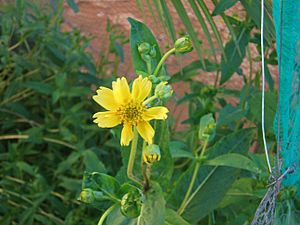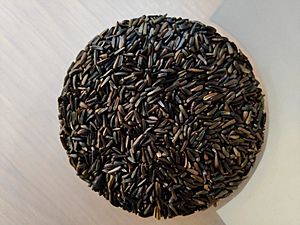Niger seed facts for kids
Quick facts for kids Niger seed |
|
|---|---|
 |
|
| Guizotia abyssinica flower | |
| Scientific classification | |
| Genus: |
Guizotia
|
| Species: |
abyssinica
|
| Synonyms | |
|
Synonymy
Anthemis mysorensis herb.madr. ex DC.
Bidens ramtilla Wall. ex DC. Buphthalmum ramtilla Buch.-Ham. ex Wall. Guizotia oleifera (DC.) DC. Jaegeria abyssinica (L.f.) Spreng. Polymnia abyssinica L.f. 1782 Ramtilla oleifera DC. Tetragonotheca abyssinica Ledeb. Verbesina sativa Roxb. ex Sims |
|
Guizotia abyssinica is a plant also known as niger seed, nyger, or ramtil. It's an annual herb, meaning it lives for only one growing season. This plant is grown for its seeds, which are used to make cooking oil and as bird food.
Niger seed first grew in the highlands of Eritrea and Ethiopia. From there, its farming spread to other parts of Ethiopia and then to other countries. People in different places have different names for it, like nūg in Ethiopia and Eritrea, and blackseed.
Contents
Niger Seeds: What Are They Like?
Niger seeds are native to Ethiopia, Eritrea, and Malawi. They are also grown in India. These seeds look a bit like tiny sunflower seeds, but they are smaller and black. Each seed has a thick outer layer that sticks to it. This helps the seeds stay fresh for up to a year without going bad.
Niger seeds are packed with good stuff! They contain proteins, oil, and natural sugars. These seeds are a popular choice for bird feed around the world.
What's Inside Niger Seeds?
Here's a quick look at what makes up niger seeds:
| Component | Percentage |
| Oil | 30%–40% |
| Proteins | 10%–25% |
| Soluble sugars | 12%–18% |
| Crude fiber | 10%–20% |
| Moisture | 10%–11% |
Keeping Seeds Safe for Birds
When niger seeds are imported for bird food, they are heated. This intense heat makes sure that no unwanted seeds, like weeds, can grow if they get mixed in. This helps protect native plants in the places where the birdseed is used.
Growing Niger Seed
Niger seed plants need a good amount of rain, about 1000 to 1250 millimeters (40 to 50 inches) each year. They grow best in moist soil. The plants can grow in light black soils or brownish loam that is deep enough. They also do well in heavy soils that drain water easily or rocky laterite soils. Niger plants can grow in partial shade or full sun.
Farmers can expect to get about 300 to 400 kilograms of seeds per hectare (about 270 to 360 pounds per acre) in good conditions. Sometimes, they can even get up to 600 kg/ha (535 pounds per acre). This plant is known for giving a steady amount of seeds even when the weather isn't perfect.
Niger Seed as Bird Food
The seed of the niger plant is actually a type of fruit called an achene. It's very popular with finches, especially goldfinches and greenfinches. In stores, you might hear niger seed called "thistle seed." This name was used early on to make people think of thistles, which finches also love.
To avoid confusion and a common mispronunciation, the Wild Bird Feeding Industry (WBFI) created the trademarked name "Nyjer" for Guizotia abyssinica used as bird food.
Protecting Against Weeds
In 1982, the U.S. Department of Agriculture (USDA) started requiring that imported niger seed be heat-treated. This was to kill dodder seeds, which are a type of weed. Later, in 2001, a new treatment was required: heating the seeds to 120°C (248°F) for 15 minutes. This stronger heat treatment helps kill other harmful weed seeds that might be mixed in.
Growing Niger in the United States
In 2002, a new type of Guizotia abyssinica called 'EarlyBird' was developed. This variety grows quickly, maturing in just 65 days, making it suitable for farming in the United States. Another variety, 'Earlybird 50', matures even faster, in 50 days. It's also shorter, produces more seeds, and is less likely to fall over.
Niger is not considered a harmful weed in the U.S. It is now grown commercially there, often before or after other crops like wheat, maize, soybeans, and cucurbits. Niger plants need bees to help them pollinate and produce seeds.
Niger Seed Oil
Niger seeds contain a good amount of oil, usually about 30–35% of their weight. This oil is clear, edible, and dries slowly. It's a type of polyunsaturated oil. Niger seed oil has a pale yellow or orange color, a nutty taste, and a sweet smell. When it's fresh, it has low acidity, so it can be used directly for cooking.
However, niger oil doesn't stay fresh for a very long time and can go bad if stored for too long. Its makeup is similar to sunflower oil, with a lot of linoleic acid. It can be used instead of olive oil or mixed with linseed oil. The amount of linoleic acid in the oil can change depending on the soil and the type of seed, ranging from 45% to 65%.
Oil Characteristics
Here are some physical details about niger seed oil:
| Characteristic | Range |
| Refractive index 400C | 1.4655–1.4673 |
| Saponification value | 187–195 |
| Iodine value | 112–129.0 |
| Unsaponifiable matter | 0.5–1.0% |
| Moisture | 0.5–0.75% |
| Bellier turbidity temperature | 24.5–27.8 °C |
| F.F.A | 0.2–2.0% |
Fatty Acids in Niger Seed Oil
This table shows the different types of fatty acids found in niger seed oil:
| Fatty acid | Percentage |
| Myristic acid (C14:0) | 1.7%–3.4% |
| Palmitic acid (C16:0) | 5.8%–13.0% |
| Stearic acid (C18:0) | 5.0%–7.5% |
| Oleic acid (C18:1) | 13.4%–39.3% |
| Linoleic acid (C18:2) | 45.5%–65.8% |
Uses of Niger Seed
Niger seeds have many uses, from food to industrial products.
Cooking and Medicine
In southern parts of India, people eat niger seeds. In states like Karnataka, Andhra Pradesh, and Maharashtra, the seeds are roasted and ground to make a dry chutney. This chutney is eaten with breads like chapati. Sometimes, the seeds are also used as a spice in curries.
In Ethiopia, people make a drink from roasted and ground niger seeds, sugar, and water. This drink is traditionally used to help treat common colds.
Other Uses
- Leather Treatment: In Ethiopia, a paste made from roasted and ground niger seeds mixed with roasted and ground flaxseeds (called telbah) and hot water is used to treat leather.
- Industrial Products: The oil from niger seeds is used in factories to make things like soap and paints. It's also used to prepare different types of emulsions.
- Bird Food: As mentioned, niger seeds are a very popular food for birds. Because the seeds are so small, special bird feeders are made just for them. In the United Kingdom, these seeds attract finches and siskins.
- Livestock Feed: After the oil is taken out of the seeds, what's left is called niger oil cake. This cake is full of protein and is used to feed farm animals, especially in Ethiopia.
See also
 In Spanish: Guizotia abyssinica para niños
In Spanish: Guizotia abyssinica para niños



